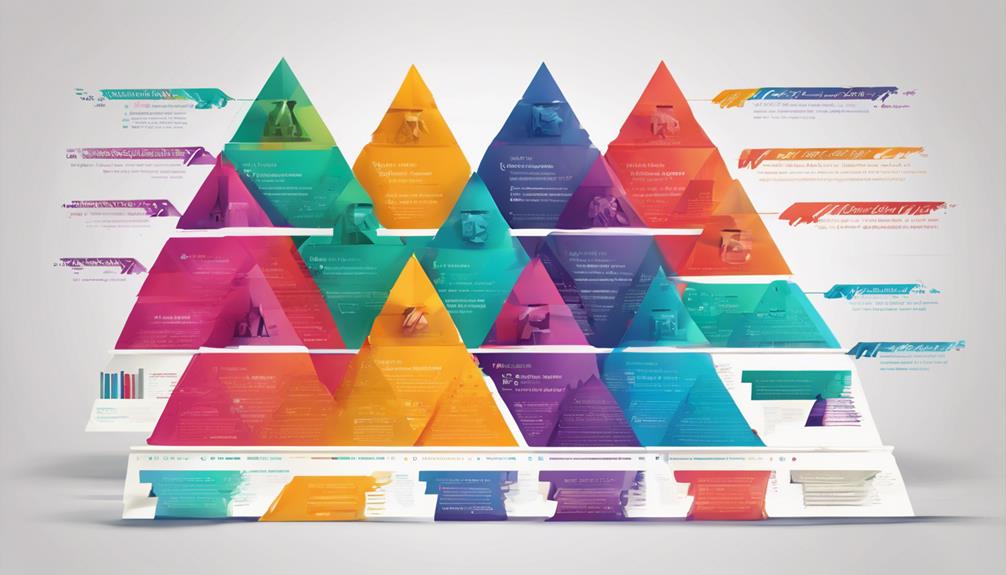You're likely aware that mastering header tag hierarchy is crucial for SEO success, but have you considered how it can transform user engagement? When you strategically structure your content from H1 to H6, you not only guide search engines but also create a seamless experience for readers. It all starts with understanding the role each header plays in content organization and how to implement them effectively. The nuances of this hierarchy can significantly influence your site's visibility and user interaction. So, what's the secret to using header tags to their full potential? Let's explore further.
Key Takeaways
- Use a single H1 tag per page to encapsulate the main topic with primary keywords.
- Sequence header tags logically from H1 to H6, maintaining a clear content hierarchy.
- Incorporate keyword-rich phrases naturally in headers to enhance SEO without compromising readability.
- Ensure each header level supports the main H1, aiding both search engines and user understanding.
- Avoid keyword stuffing in headers; keep them concise and relevant for better SEO performance.
Importance of Header Tags
Understanding the importance of header tags is crucial for optimizing your site's SEO performance.
Header tags, ranging from H1 to H6, serve as the backbone of your content structure, guiding both search engines and users through your webpage. Using these tags correctly can significantly boost your rankings by signaling the relevance and hierarchy of your content.
Your H1 tag should encapsulate the main topic, making it clear what the page is about. It's vital to ensure this tag includes primary keywords, as it plays a significant role in search engine algorithms.
Structuring Your Content
When it comes to structuring your content, breaking it down with header tags is essential for both SEO and user engagement. Header tags create a logical flow, making it easier for search engines to understand your content's hierarchy. By using these tags strategically, you can highlight key points, improve readability, and guide users through your content seamlessly.
Start by identifying the main topics and subtopics within your content. Each section should have a clear focus, with header tags reflecting this structure. Use keyword-rich phrases in your headers to signal relevance to search engines. This approach not only boosts your SEO but also helps readers quickly find the information they need.
Remember to maintain a logical order. Your content should flow naturally from one section to the next. This ensures users stay engaged and reduces bounce rates. Additionally, search engines reward well-organized content with higher rankings.
Keep your headers concise and informative. Avoid keyword stuffing, as it can harm your SEO efforts. Instead, focus on delivering value and clarity. By structuring your content effectively, you enhance user experience and improve your chances of SEO success.
Implementing H1 to H6 Correctly

Implementing header tags from H1 to H6 correctly is crucial for optimizing your website's SEO and enhancing user experience. These tags organize your content and signal search engines about the structure of your page, boosting your site's visibility.
To get the most out of your headers, follow these key strategies.
1. Prioritize the H1 tag: Use the H1 tag for your main title. It should encapsulate the primary topic of your page and include targeted keywords. Limit yourself to one H1 tag per page to maintain focus and clarity.
2. Sequence your headings logically: Start with H1 and descend to H6 as you delve deeper into subtopics. Each level should break down the content into smaller, more specific sections that support the main H1 heading.
This hierarchy helps search engines and users understand the flow and relevance of your content.
3. Use keywords strategically: Incorporate relevant keywords naturally within your headers. This enhances SEO without compromising readability. Avoid keyword stuffing, which can lead to penalties from search engines.
Enhancing Readability With Headers
Headers' impact on your webpage's readability can't be overstated. They guide your audience through the content, offering a clear structure and flow. When you use headers effectively, users can quickly scan the page, understanding its main points without getting lost in long paragraphs. This improves user experience and keeps visitors engaged longer, which can positively affect your bounce rate and SEO.
To enhance readability, start with logical header hierarchy. Use H1 for the main topic, H2 for sections, and H3 for subsections. Consistent use of this structure aids readers in navigating complex information seamlessly. Ensure headers are descriptive and keyword-rich, enhancing both readability and search engine visibility.
Additionally, headers break up text, making content less overwhelming. Short, concise headers act as signposts, helping readers find the information they need swiftly. This approach caters to varied reading styles, whether skimming or in-depth exploration.
Moreover, headers should align with your page's design. Use a font size and style that stands out but remains consistent with your brand. This visual differentiation emphasizes importance, guiding readers naturally through the content. Implementing these strategies ensures your site is user-friendly and SEO-optimized.
Common Header Tag Mistakes

A common pitfall many website owners fall into is the misuse of header tags, which can significantly impact SEO performance. Misunderstanding header tag hierarchy can confuse search engines and disrupt your content's flow. To avoid these missteps, it's crucial to understand common header tag mistakes and how to correct them.
- Overusing H1 Tags: You might think adding multiple H1 tags emphasizes key points, but it actually dilutes the focus. Each page should have only one H1 tag to clearly indicate the main topic. An excess of H1 tags misguides search engines and can hurt your rankings.
- Ignoring Hierarchical Order: Skipping levels, like jumping from H1 to H4, disrupts the logical flow. This not only confuses search engines but also creates a jarring experience for users. Ensure a natural progression from H1 to H2, H3, and so on.
- Keyword Stuffing: It's tempting to pack header tags with keywords, but this can lead to penalties. Headers should be relevant and concise, highlighting the section's content without overloading keywords.
Conclusion
By mastering header tag hierarchy, you boost your SEO success and enhance user experience. Use H1 tags for main titles, and organize your content with H2 and H3 for clear structure. Naturally integrate relevant keywords in headers to signal content relevance to search engines, improving visibility. Avoid pitfalls like overusing H1 tags or keyword stuffing. With these strategies, you enhance readability, improve search rankings, and engage your audience effectively. Implement these techniques for optimized content.


Leave a Reply